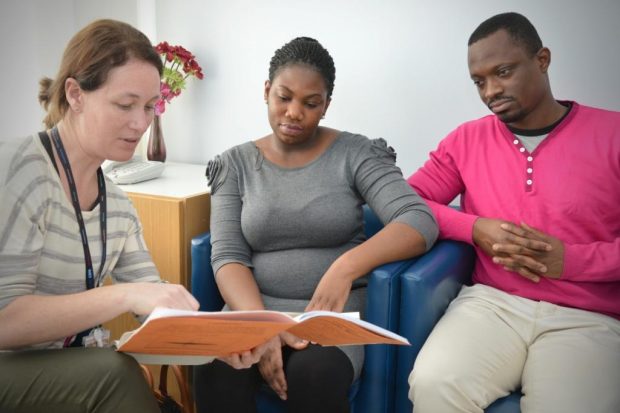
Antenatal screening for sickle cell and thalassaemia (SCT) helps identify people who are genetic carriers for sickle cell, thalassaemia and other haemoglobin disorders.
If 2 people who are carriers have a baby together then there is an increased risk that the baby could inherit a haemoglobin disorder.
The increasing number of pregnancies resulting from egg or sperm donation presents an additional challenge for SCT screening providers.
Local screening services should adhere to the following best practice:
- If a donor sperm has been used and the mother has a positive screening result then, where possible, you should contact the fertility clinic to obtain the donor’s haemoglobinopathy results.
- If pregnancy has been achieved through a donor egg then you should invite the baby’s biological father for screening immediately. The same applies if the mother has had bone marrow transplant. If the biological father tests positive, you should contact the fertility clinic to obtain the donor's haemoglobinopathy results.
- All pregnant women, including those who have used fertility treatment (in this case a donor egg), should still be tested for haemoglobinopathy to ensure optimal maternal care during pregnancy.
Last year, we published guidance on special circumstances for antenatal screening and we recently told you about changes to the family origin questionnaire (FOQ) to help midwives and nurses who offer antenatal SCT screening.
We introduced a new question ‘Is pregnancy the result of IVF?’ at the top of the FOQ to reinforce the need to complete section H for IVF pregnancies.
Scenarios highlight variation in practice
The UK National External Quality Assurance Screening (UK NEQAS) is helping to raise awareness of this issue. It is educating laboratory scientists by including specimens and scenarios from pregnancies that result from egg donation and mothers who have a history of bone marrow transplant.
UK NEQAS Haematology regularly surveys the performance of laboratories by sending the same batch of abnormal haemoglobin samples to all participating labs. The labs analyse the samples and send comments back to UK NEQAS on how they would report and interpret the findings.
In a recent survey, UK NEQAS included a scenario that described a specimen from a 39-year-old South American woman who was pregnant via egg donation.
The woman’s haemoglobinopathy screening results and full blood count (FBC) data were normal. As the pregnancy was achieved via egg donation, the woman’s haemoglobinopathy screening results did not accurately represent the risk to the baby, so the biological father should be invited for screening. If the biological father’s screening result is then positive, the recommendation should then be that the fertility clinic is contacted to obtain the donor's haemoglobinopathy results.
A total of 139 UK survey participants returned comments on this scenario. 131 (94%) reported no evidence of a haemoglobin variant or thalassaemia and only 99 (71%) reported that the baby's biological father should be offered screening. 22 UK participants incorrectly thought that testing the baby’s biological father was not required and 17 of these were English NHS laboratories likely to undertake antenatal screening.
A similar scenario was repeated in a subsequent distribution, with a sample from a 41-year-old South Asian female, pregnant via egg donation. In this case, 132 UK participants returned comments and 117 (89%) reported no evidence of an abnormal variant or thalassaemia. 108 (82%) of UK laboratories correctly suggested the baby’s biological father should be tested, an apparent improvement on the 71% of the earlier case. However, 8 English NHS laboratories, likely to undertake antenatal screening, still stated that testing the baby’s biological father was not required.
The apparent improvement in performance between these 2 exercises illustrates the importance of sharing best practice through external quality assurance (EQA). UK NEQAS will continue this approach to reinforce the information provided by the NHS SCT Screening Programme in its handbook for laboratories and on training days.
PHE Screening blogs
PHE Screening blogs provide up to date news from all NHS screening programmes. You can register to receive updates direct to your inbox, so there’s no need to keep checking for new blogs. If you have any questions about this blog article, or about population screening in England, please contact the PHE screening helpdesk.